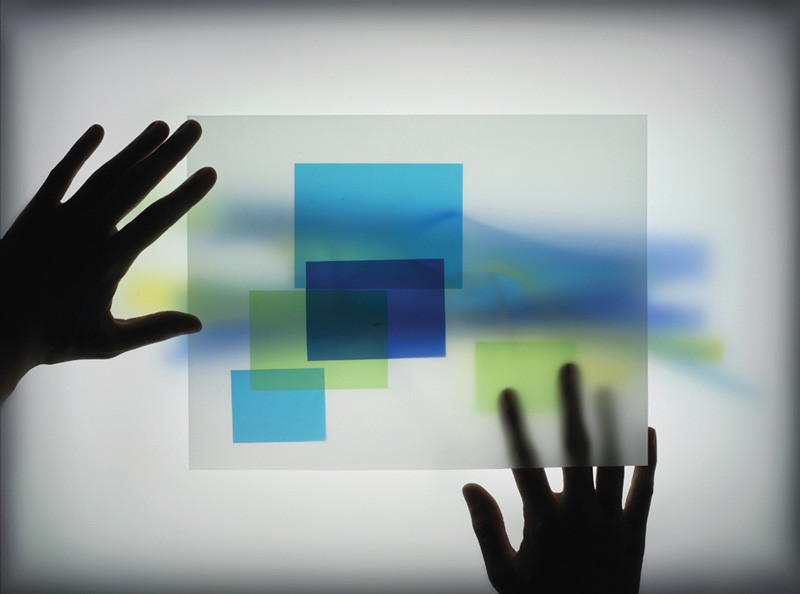[Fall 2009]
Galerie de l’UQAM, Montreal
February 27 to March 28, 2009
Manon De Pauw practices a corporeal poetics as inventive and involute in its physical articulation as it is varied and inviting in its philosophical approach. Her manner of thinking the body – the “universal thing” – sheds light on the meaning of corporeality in the context of contemporary videographic and photographic work. The how and the why of it were demonstrably clear in this selection of works at UQAM, presented in an exhibition curated by Louise Déry. In sundry photograms, photographs, video performances, performance set-ups, single-channel videos, and multi-channel video installations, she sings the body eclectic.
In works such as Répertoire (2009; videographic installation with six projections in loop, table in wood and metal, Plexiglas, and mixed media), L’apprentie (2008; digital proof, inkjet print, and light box), Là où je vis (2008; video, colour, sound), and the stunning Fantasmagorie lumineuse (2008; video, colour, sound), De Pauw methodically explores body, image, and manifold textures of light. She is writing the self in the foreground of the virtual in the language of light and shadow. Her manipulations of the image are profoundly experimental and phenomenological in scope and tenor. She convinces us that the phenomenological is by no means an archaic language for work such as this, but a pressing and topical one. Her theatre of operations is at once spatial, temporal, and sensibly transcendent.
This work explores the private body – her body, that is – as existential integer and ultimate reference pole. While she celebrates her own somatic experience and Schilderian body image in work that makes an exhilarating use of recent technology understood as existential technics, that work always reaches outside of itself, and achieves the implication of and dialogue with constituting alterity. This “becoming- other” as a result of “reaching toward” is at the heart of this work.
If all of the work in this exhibition registers a triumph of the tremulous private body as a radical thought experiment, the epiphany in the viewing lies in a phenomenal tactual dimension, a subliminal Braille that we read with fingertips wed to our retinas. Beyond that, it is almost as though she uses an anamorphic polyprism to free her viewers from any fealty to a Cartesian subject long since worn threadbare.
Clearly, she takes a cue from a phenomenology refracted through the prismatic array of feminist thinkers such as Luce Irigaray and Catherine Vasseleu. For Irigaray, “Refigurings of the relation to the self are ‘read off’ the form of the female body or rather, the female bodymorph. The bodymorph can be thought of as a sort of discursive, langue-like substrate supporting the particular, parole-like discourse of female difference.”1
As far as the ubiquitous bodymorph goes, one of the most significant works in the exhibition was Replis et articulations (2004). This remarkable video triptych presents a series of actions performed by the artist, choreographed on three screens, on a black platform serving as both canvas and corporeal arena. In performing, the body acts and is acted upon, and the innate rhythms rule our appreciation of the piece as a corporeal fantasia that is also a powerful metaphor for introspection and avowal and the intertwining of what is visible and invisible therein.
De Pauw is an on-stage illusionist, a savvy manipulator of media and image, working with the teaching and learning experience and the classroom as a laboratory for the incubation of vision freed from old ways of seeing and thinking. We see her drawing on large white sheets of paper, and what she delineates is perfectly in keeping with her intentions and her virtuosity: a Giotto-like circle. Her pedagogical slant dovetails with her phenomenological concerns. Corps Pédagogique (2001) is not only an audiovisual take on the quintessential classroom environment but a subversive exploration of that environment with her own body as avatar to explode the myth of the neo-Cartesian subject.
Simultaneously crossing borders between the material and immaterial, the visible and invisible, de Pauw bends both to her will with admirable dexterity. The rhythm section in her work enjoys primacy. What I mean is that when we see her shifting her body fraction by fraction in centrifugal movements, we have a sense of the primacy of her rendering a world for herself within specific limits that speak not of closure but of porosity and openness and the primacy of the body as agent. When her body travels laterally, levitation-wise, across a school desk, it is the inexorable rhythm that compels us, it is the mantra of movement that commands us, and we are delivered onto the threshold of something like revelation as a result.
These rhythms are based not only on corporeal authenticity but on the symbolic cartography of the body implicit in phenomenological discourse. This symbolic mapping of the body in the context of where it finds itself in time and space makes for a rare epiphany in the assimilation of this work. As Merleau-Ponty wrote, “What counts for the orientation of the spectacle is not my body as it in fact is, as a thing in objective space, but as a system of possible actions, a virtual body with its phenomenal ‘place’ defined by its task and situation of possibilities or corporeal projects that are made possible by this interaction.”2 He also wrote, “To move one’s body is to aim at things through it; it is to allow oneself to respond to their call.”3 De Pauw moves the body toward and through situations that shed light on embodiment, the bodymorph, and the reciprocal relation of self and Other.
3 Ibid.,p.139.
James D. Campbell is a writer on art and independent curator based in Montreal. The author of over 100 books and catalogues on contemporary art and artists, he contributes frequently to visual arts publications across Canada.


